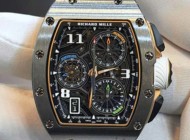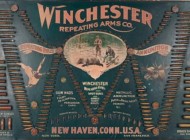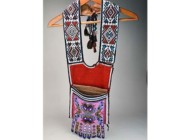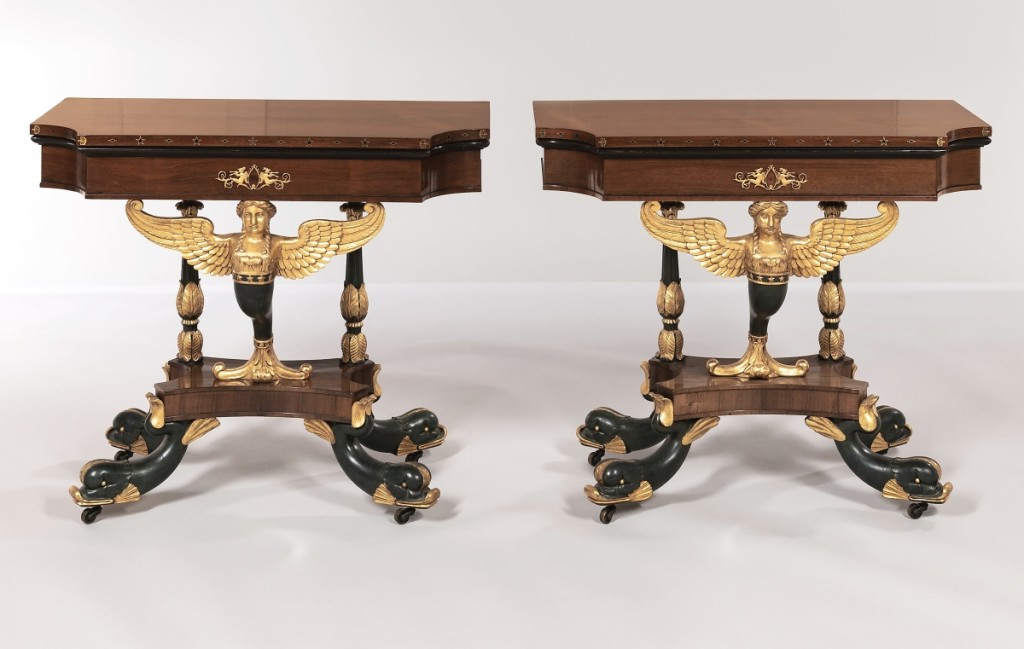
The only word that could begin to describe these tables would be “gorgeous.” They brought the second highest price of the Keane sale, $262,500. The pair of classical rosewood, gilt-gesso and antique brass inlaid card tables by Charles-Honore Lannuier of New York, were made about 1815 and are part of group of 19 such tables attributed to him.
Review and Onsite Photos by Rick Russack, Additional Photos Courtesy Skinner, Inc.
MARLBOROUGH, MASS. – On November 19, Skinner sold the John and Marilyn Keane collection, which Steve Fletcher and Chris Barber both called “probably the best collection of late Eighteenth Century and early Nineteenth Century material we’ve handled in a decade or more.” It was a live sale, but the in-house bidders were few; however, the phone lines and the three internet platforms were busy throughout and there were a number of absentee bids. Ample preview time in the days preceding the sale allowed those considering a purchase the chance to closely examine any items they might be interested in. The Keane collection grossed $1,974,718. On the evening of November 22, a “timed” auction of Americana, including three Andrew Clemens sand bottles, ended. The sand bottles grossed $1,798,750 [see accompanying article]; the total for the online sale was $2,191,750, and together, the two sales grossed $4,166,468.
The Keane collection included about 100 lots of outstanding American furniture and several China trade paintings. The Keanes were discriminating collectors, having bought many of their items from the leading dealers in the fields they were interested in. Both were active in the Boston arts community, including the Museum of Fine Arts, which named its Newport furniture wing in their honor.
Keane collection items bringing more than $100,000 each included two furniture lots and two Chinese export paintings. Leading all was a Chippendale carved mahogany marble top slab table, which brought $396,500. The circa 1765 table had a serpentine front edge, applied gadrooning, with acanthus-carved cabriole legs. It had previously been in the collection of Mr and Mrs Lamont du Pont Copeland, and a 1985 letter from antique furniture specialist Luke Beckerdite to Mrs Copeland attributed the carving to Philadelphia carvers Nicholas Bernard and Martin Jugiez. It was illustrated in Helen Comstock’s 100 Most Beautiful Rooms in America, and “Living with Antiques: The Delaware Home of Mr and Mrs Lamont Copeland,” The Magazine Antiques, October 1952.
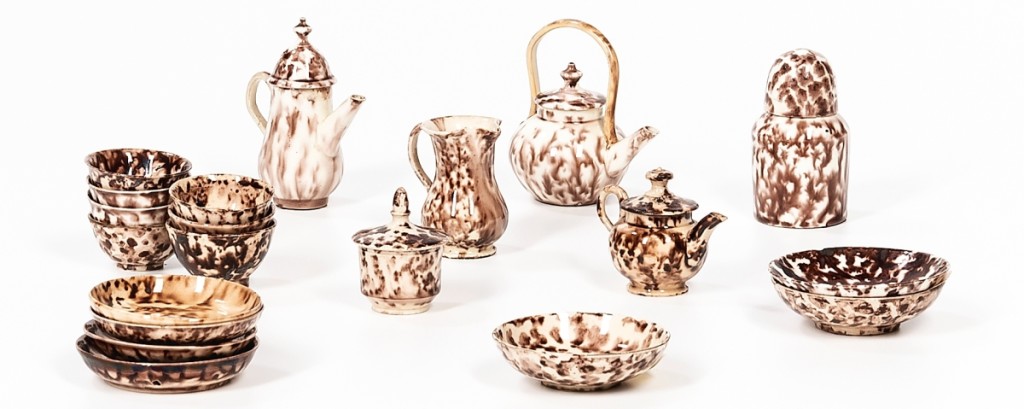
The tallest piece of this miniature Staffordshire tortoiseshell-glaze tea set, dating to the third quarter Eighteenth Century, was only 3 inches tall. The set included three teapots, a tea caddy, a cream jug, a covered sugar bowl, seven tea bowls and saucers, and it realized $1,250.
Bringing the second highest price of the day was a pair of classical rosewood, gilt-gesso and brass inlaid card tables by Charles-Honoré Lannuier of New York, circa 1815. That pair brought $262,500. It would certainly be fair to call them exceptional. Each had a shaped hinged top with concave corners, the edges were inlaid with brass stars and diamonds, and it had ebonized molding, with ormolu mounts depicting nymphs playing panpipes. Each base depicted a carved gilt-gesso winged female figure with braided hair and a star-banded waist. The rear fluted columns were carved with gilded acanthus leaves and bases had carved dolphin feet. Four phone bidders competed. These tables, according to the catalog, “utilize one of Lannuier’s favorite elements, winged caryatid supports, and are two of a known group of 19 card tables attributed to him, and are the only known pair with carved dolphin feet.”
Other exceptional furniture included the Hezekiah Smith Chippendale carved mahogany bonnet-top block-front desk and bookcase made by an unidentified cabinetmaker in Boston, circa 1765. It’s a large, imposing piece of furniture with swan’s neck cresting, three flame finials, dentil molding and scalloped raised panel doors in the top section. The interior drawers of the desk are fan-carved and it sits on short ball and claw feet. An 1805 inventory of Smith’s estate listed it and valued it at $40. It had an old surface and brasses thought to be original. It sold for $75,000. It had remained in the Smith family until 1998 when Leigh Keno sold it to the Keane family. A circa 1760 Chippendale mahogany block-front four-drawer chest made in Boston realized $50,000.
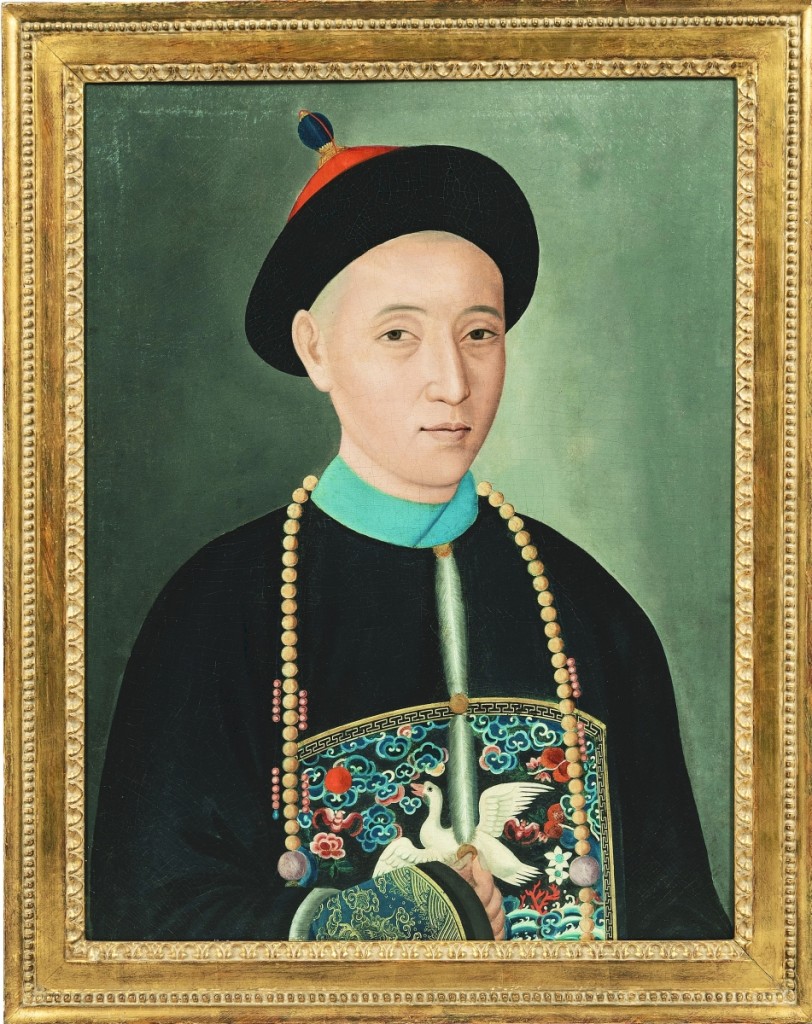
An unsigned portrait of a Hong merchant, possibly Chung Qua, attributed to Spoilum sold for $162,500. Spoilum is believed to have been very active during his life, and is credited with many portraits of Chinese, English, American and even Indian merchants who came to trade at the Hongs of Canton.
The third and fourth highest priced objects in the sale were China trade paintings, of which there were several exceptional examples. A portrait of a wealthy, well-dressed Hong merchant, possibly Chung Qua, attributed to Spoilum (Chinese, active 1785-1810), sold for $162,500. Spoilum portraits are extensively discussed in Carl Crossman’s, The Decorative Arts of the China Trade, who describes him as the earliest and best known of the Cantonese painters active in the time period. Crossman also described another of the paintings, “An Imperial Review at a Military Encampment” possibly by Spoilum, thusly: “one of the most ambitious of all genre paintings depicting Chinese life painted for the western market, the scene presents an imperial military review with detail and grace, uncommon for export paintings of this period.” It realized $93,750. An unsigned view of Singapore showing a variety of vessels and the harbor front realized $106,250. The buildings portrayed the work as circa 1847-1855. The other paintings in the sale did well, but there was one unusual, possibly unique, China trade item, which, while selling well over the estimate, could be difficult to find again. It was a cabriolet fan of Hong Kong, opening to 21½ inches and decorated with a watercolor panoramic view of a busy Hong Kong harbor. Dated to the Nineteenth Century, the fan, in a fitted satin-lined black lacquer box, brought $3,750.
The member of the Keane family who consigned the collection was present for the sale.
Ending a few days later, a “timed” sale of Americana did well. Three sand bottles by deaf mute Andrew Clemens collectively sold for $1,798,750. In addition, the “timed” sale included scrimshaw, a large selection of Chines export porcelain, mocha, American and European paintings, early country and formal furniture, weathervanes and more. Aside from the sand bottles, the highest price achieved, $15,000, was for a Nineteenth Century scrimshaw-decorated whale’s tooth, with one side showing a three-masted ship below an eagle, flags, garlands and a banner reading “The Ship Mary,” with smaller vessels on the other side. Another tooth, with one side showing warships engaged in battle, earned $8,125, far above the estimate. A Nineteenth Century American school painting of the Hawthorne woolen mills, possibly in Greenwich, Conn., sold for $10,625. An inscription on the reverse reads “Destroyed by fire/Saturday morning between 2+3/June 26. 1875.”
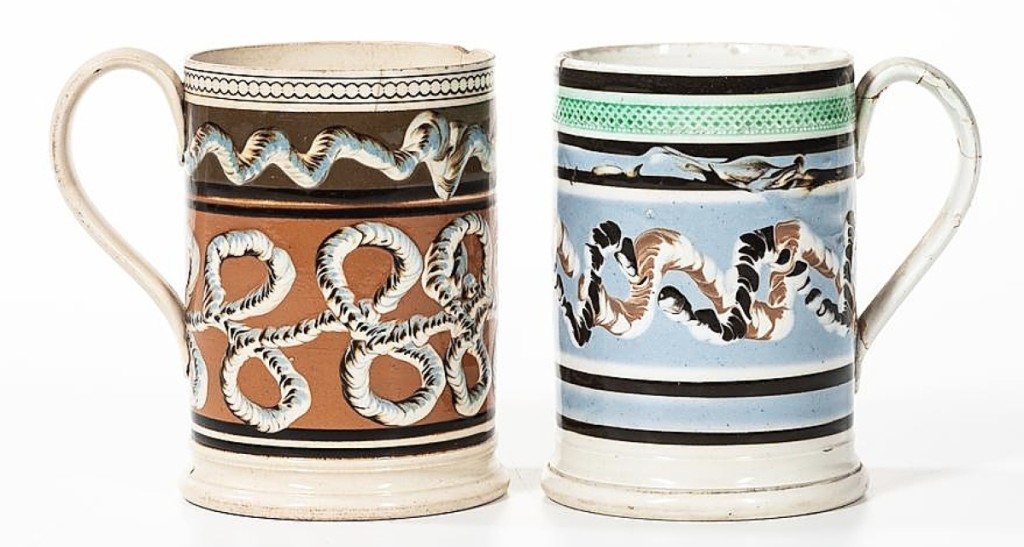
The numerous pieces of mocha included these two slip-decorated 1-quart mugs. Made in England, dating to the early Nineteenth Century, the two went out for $1,188.
After the sales, Steve Fletcher commented, “We did more than $4 million, and I wish we could find a few more sand bottles. For the most part, things sold pretty much as we had anticipated. The quality was consistent throughout. The Keanes had very good taste and they knew and understood the material they collected. They bought from the specialist dealers and paid what they had to. Personally, I think their apartment was probably the most outstanding that I’ve ever been in. There were two items that surprised me – one was the China trade fan decorated with the panoramic harbor view. It was a really special item and could have brought a lot more money. The secretary desk was a good buy. It was a beautiful example but that form, be it formal or country, doesn’t fit in every home. It’s a large piece of furniture – the smaller pieces fit in more homes. The consignor was there and when the sale was over, he said to us ‘you did a good job.’ That made our day. The timed sale was strong, and we’re seeing more and more participation as time goes on.”
Prices given include the buyer’s premium as stated by the auction house. For information, 508-970-3200 or www.skinnerinc.com.




























